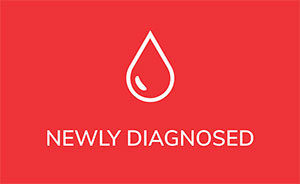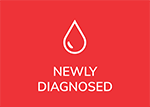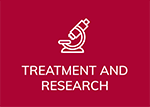Updated on: 8/9/2023
Takeaway Points:
- Watch and Wait or Active Surveillance can be an appropriate treatment strategy
- There is no evidence that early treatment is of any benefit in chronic lymphocytic leukemia (CLL).
- Treatment should be based on what is going on with us patients and in most cases not with our ALC (absolute lymphocyte count).
Quiz (Where we get to play doctor)
Nine months after diagnosis, a fellow patient with CLL tells you that his WBC (white blood cell count) is 49,000 with an ALC (absolute lymphocyte count) of 42,000. He has clusters of 2 x 1 cm nodes in both axillae (armpits). Labs are otherwise OK. He feels well, just a bit tired and stressed. He asks what symptoms or lab results might indicate it is time to treat. You tell him:
- Unexplained fever >38°C x 2 weeks with no infection
- Unexplained weight loss >10% over 6 months
- Drenching night sweats >1 month with no infection
- Severe fatigue
- WBC >100,000
- All the above
- 1-4
The correct answer is number 7.
Many doctors get it wrong and answer # 6.
This is yet another good reason to become our own expert or make sure we are consulting with one.
Reasons To Treat Include:
- B Symptoms (there are no A symptoms)
- Weight loss >10% of body weight in previous 6 months
- Severe fatigue (ambulatory and capable of all self-care but unable to carry out any work activities
- Fevers >38°C for at least 2 weeks without evidence of infection
- Drenching night sweats for more than a month without evidence of infection
- Evidence of progressive bone marrow failure manifest by low blood counts (cytopenias) including anemia (low red blood cells) or thrombocytopenia (low platelets)
- Massive or symptomatic splenomegaly (enlarged spleen)
- Massive lymph nodes or clusters of nodes (>10 cm) or progressive or symptomatic lymphadenopathy (enlarged lymph nodes)
- Autoimmune Hemolytic Anemia (AIHA where the body attacks its own red cells) and/or Immune Thrombocytopenic Purpura (ITP where the body attacks its own platelets) that is poorly responsive to steroids or other standard therapy
- Rising ALC with an increase of more than 50% over a 2-month period or a lymphocyte doubling time (LDT) <6 months. If ALC is <30,000, LDT should not be used as the only criterion for beginning treatment.
- The last indication for treatment, namely a rapidly rising ALC is controversial.
Please note there is no absolute level of ALC that demands treatments.
Watch and Wait (Active Surveillance):
It seems so counterintuitive. And frustrating. We learn that we have cancer, and then we are told to sit on our hands and watch and wait or our preferred terms, Active Surveillance or Active Observation, until our cancer becomes bad enough that we need to treat it. Shouldn’t we want to try to knock it out when it is still in its infancy and has not become an aggressive and often bulky adversary? The answer to this question as of today is a resounding NO!
The reason behind this recommendation that we avoid treatment until we have significant symptoms (See article on symptoms) and instead are told to “Watch And Wait” or as many of us say “Watch and Worry” as that there is no evidence that any early therapies are helpful. In fact this famous study published in 1998 compared “Watch And Wait”to early intervention with chlorambucil, an oral chemotherapy and at that time the standard of care, and found that the group on chlorambucil fared slightly worse.
Admittedly, we have much better treatments today. What we know now is that we didn’t know back then is that a significant percent of us can be predicted based on our prognostic indicators to possibly never need treatment and to have a normal life expectancy. Taking even a “gentle” chemotherapy such as chlorambucil can’t improve on an already normal lifespan and is more likely to increase the mortality and morbidity for that group.
Since that 1998 study, as Dr. Furman points out in the video that follows, for a variety of reasons, nothing has proven to make a difference in improving our overall survival, but there are reasons to believe that it is worth setting up trials to investigate whether it might help to intervene earlier with some of the newer drugs in the highest risk patients.
Until we have the results from trials where newer agents are used before there is any “reasons to treat” in untreated patients, the data just doesn’t support early treatment. But, that being said, I think these the trials need to be done to test this theory.
REASONS TO TREAT:
The take away points at the beginning of the article lists what the experts mostly agree are valid reasons to start treatment. Understand that these guidelines were put together by putting many CLL experts in a room and locking the door until they agreed on a set of rules. They have never been studied in clinical trials. They just make sense.
Moreover, these rules are not hard and fast. For example, a platelet count of less than 100,000 is abnormally low and an indicator for treatment in most guidelines, but if it is stable and not in a free fall, then it is reasonable to discuss with our doctor the possibility of waiting and following the trend. The concern is that if our counts went too low, then most therapies would be off the table, as we couldn’t tolerate a further drop in our blood levels that is so common with more chemo. Now, while this is still a worry, it is less so today because many of the new treatment options are not as hard on the bone marrow and can be used more safely even when we already have low counts.
That remains the tricky part. We don’t want to wait until we are too sick to tolerate the necessary therapy to control our disease, but we sure don’t want to intervene too soon.
OncLive Peer Exchange Video:
Introduction: Upfront Treatment in Patients With CLL
This video features a who’s who in CLL research. I am grateful to OncLive for arranging it and posting it on youtube.com. It addresses the issue of when to treat and the risk of treating too soon.
Dr. Kipps says and I agree: “We have a lot of new very exciting treatments coming down the pike, but I think it’s a fair statement that if I were a CLL patient, I’d much rather be treated tomorrow with even better understanding about how to use these new agents than being treated today.”
Brian Koffman 2/24 Updated 8/24 Edited by Terry Evans

















